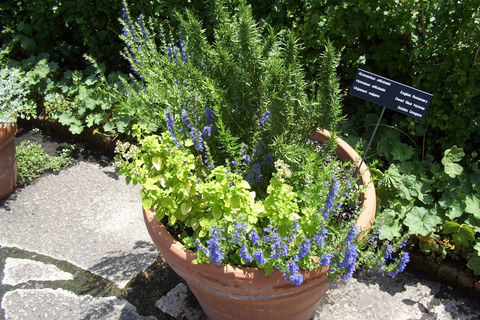Gardening in small spaces
UNIVERSITY OF MINNESOTA EXTENSION - www.extension.umn.edu
Gardening in small spaces requires you to maximize the space you have and keep potential problems under control. Here we review the top things to consider when gardening small.
Choose your plants wisely
Compact pepper plants and determinate tomatoes were chosen for this space because they grow well in containers.
When growing in a small space, it’s hard to fight the temptation to plant too many things. Plants that are too close together end up competing for nutrients and light and a dense plant canopy can lead to more disease pressure. So, fewer plants that are properly spaced will actually give you a better yield than squeezing many plants in the same space.
With that in mind, avoid planting things like pumpkins and winter squash in a small garden - these crops take up a lot of space and are easy to find at farmers markets later in the summer. Stick to smaller plants to grow a wider variety of things.
For small containers like window boxes, herbs, annual flowers and leaf lettuce are great choices. These plants grow quickly, and you can usually get many harvests throughout the summer. An extra bonus to growing herbs is that you can dry them and enjoy them throughout the year.
When looking for plants that will grow well in containers, look for terms like "compact," "tidy plant habit" or "short stature" on plant or seed pack descriptions.
For some common vegetables, you’ll need to decide between determinate and indeterminate varieties.
- A determinate variety will grow to a certain size and then flower and produce fruit all at once. Determinate varieties are typically preferred for growing in pots, as they require less maintenance and remain compact.
- An indeterminate variety will continue to grow, flower, and produce fruit throughout the summer. Indeterminate varieties typically require staking and pruning, whereas determinate varieties maintain a bush-like shape. If you have plenty of vertical space and trellising materials, an indeterminate variety can be a nice way to use that vertical space, allowing for other things like herbs in the understory.
Consider containers
Herbs don’t take up much space and do well in containers.
Containers are a great way to add plants to a small space, especially to sidewalk or balcony areas. They are also a good choice for renters whose landlords will not allow for a garden in the ground.
Check out our article about container gardening from last season for more information and tips.
Succession planting for fresh veggies all summer long
Succession planting is a key concept for small-space growers. If your goal is to have fresh produce all season long, space out your plantings by a couple of weeks rather than planting all at once.
Succession planting works especially well for short-season vegetables like lettuce, radishes, and peas. If you’re starting seeds now, consider planting a few lettuce seeds this week, a few more two weeks from now, and a few more after that to provide a steady stream of lettuce throughout the spring. Find out more about succession planting.
Find ways to rotate
In annual gardens, crop rotation provides numerous benefits. Primarily, rotating between plant families helps to reduce disease pressure. Also, different plants use different proportions of nutrients and have varying root structures, so rotating the spots where you grow your vegetables can benefit the soil.
A few ways to rotate in a small space include building raised beds to delineate spaces, growing in pots, and coordinating with your neighbors. For example, one neighbor could grow tomatoes this year and another could grow cucumbers. Next year you can switch up who grows what, and everyone shares their harvests so you all get a bit of everything.
If you have multiple raised beds, keep your major plant families together in the same bed so that you can rotate them all to a new bed the following year. You can still interplant flowers and herbs into the beds, but try to keep the major families together. Examples of major vegetable families include:
- Solanaceous plants: tomatoes, peppers, potatoes, eggplant
- Cucurbits: cucumber, melons, squash, pumpkins
- Brassicas: broccoli, cauliflower, kale, pak choi, mizzuna, arugula, cabbage
- Apiaceae family: carrots, parsnips, cilantro, dill, fennel, parsley
- Allums: garlic, onions, chives, leeks
- Amaranths: spinach, chard, beets, amaranth
If possible, maintain a 3-4 year rotation. If you plant tomatoes in a bed this year, try to avoid planting other solanaceous plants in that bed for about 3 years. This can be hard to do in a small garden, so just do your best.
Raised beds are a great way to create distinct areas in a garden, which helps with crop rotation.

